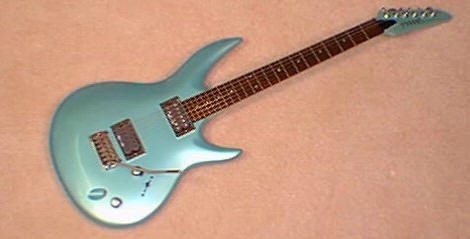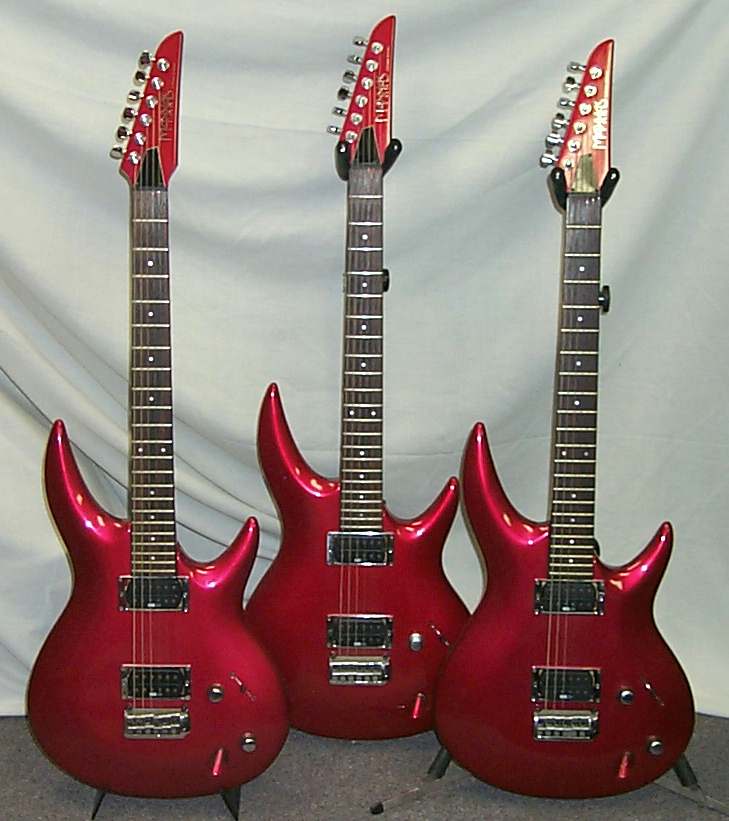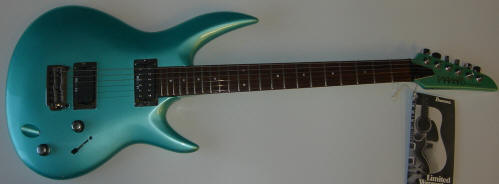Ibanez Maxxas Guitar
SOLD

BUT...If You Like The Maxxas See "The Quickislver Katana
The Maxxas was highly experimental and vastly ahead of the other new Ibanez designs released that year. Ibanez was afraid for this radical guitar to bear the “Ibanez” name. They decided that if the guitar failed that it would damage the Ibanez name, so all production models headstocks read “Maxxas.”
The guitar was awesome but it did fail. It failed for all the wrong reasons. The Maxxas was way ahead of its time and Ibanez was spineless about promoting it so the general public missed the boat on this. The few people who have them will never sell them. I bought the one above brand new and put it away.
The Maxxas has been discontinued more than 22 years and now, but Quicksilver Guitars is offering a USA made Maxxas for 2010 in the form the Quicksilver Katana. Built for comfort and playability, it is vastly superior to the original and is available in numerous wood types, colors and have options that the original Ibanez never offered. It features direct coupling, 1500G necks, hard mounted pickups and all of the same options available on a Quicksilver. I don't expect to sell many but who cares, this absolutely needs to be done. The general public usually screws themselves out of the best products. They simply don't buy them and therefore they get discontinued and everybody loses.
| Number | custom electric guitars, | Fingerboard | Rosewood |
| Brand | Ibanez | Frets | 22 |
| Model | Maxxas | Binding | No |
| Serial # | F743622 | Top | Basswood |
| Year | 1987 | Back | Basswood |
| Case | Brand New With Maxxas Logo On It | Sides | NA |
| Neck Construction | Bolt In | Wings | NA |
| Condition | Excellent | Bridge | Maxxas Traditional Type |
| Color | Seafoam Pearl Green Flip Flop | Neck | Maple |
| COA | YES | Pickups | Dimarzio IBZ |
| Code | 1G56050500-5205 | Inlay | Dots |
| Tuners | Maxxas | Hardware | Chrome |
| Extras | Power Play Backstop System | Extras | Very Rare Guitar |
| Notes | New Old Stock, Ed bought this guitar new in 1988 and put it under the bed for 20 years | ||
The Story Behind the Maxxas
By Jason D. Vaughn with many thanks to Rich Lasner
The following information about Ibanez Maxxas guitars is from a series of emails between Rich Lasner and myself. Rich is the designer of the Maxxas guitars, and he also designed the JEM, RG and Sabers, etc. He is currently the president of Modulus guitars. This communication resulted in the most complete and factual information about the Maxxas line on the web.
With the Maxxas, Rich wanted to design a lightweight guitar that did not look like the pointy-headstock Jacksons and Kramers of the time. He was also trying to create (with the semi-hollow, non-locking tremolo models) a small guitar that would sustain and “sing” at moderate volume, like a Gibson ES-335.
Bill Reim, the current President of Hoshino and the company’s former Art Director, and Rich fashioned the first Maxxas of modeling clay, which Bill had worked with extensively in art school. The original prototype Maxxas was semi- hollow with a mahogany body and a strat-like non-locking steel bridge. The tuners were locking Sperzels and the knobs were metal Tele-style. All of the hardware was plated blue. The body, neck, and headstock were the same light blue metallic color that some of the production guitars came in.

The Ibanez USA design team (Rich, Bill, etc.) made one with a pink and green snakeskin finish for an initial meeting with Steve Vai. It was the first Ibanez ever brought to him. He was very impressed by it, but since it was semi-hollow, it fed back badly at sound check. This meeting led to Vai’s working with Ibanez to create the now-legendary JEM Series.
Before the 1987 flood of new Ibanez designs led by the JEM series, most of what Ibanez offered was quite similar to everyone else’s guitars. The Maxxas was highly experimental and vastly different from even the other new Ibanez designs released that year.
Ibanez was afraid for this radical guitar to bear the “Ibanez” name. They decided that if the guitar failed as a “Maxxas” that it would not damage the Ibanez name, so all production models’ headstocks read “Maxxas—A division of Ibanez.”
The first production Maxxas guitars (MX-2) were released in 1987. The MX-2 was the only Maxxas model built with a streamlined solid basswood body, Ibanez Original Edge tremolo system, and Power Play System backstop. The MX-2s were also the very first Ibanez guitars to feature the now-standard All Access Neck Joint. Like all other Maxxas models, the MX-2 featured IBZ-USA humbuckers made by DiMarzio.
The MX-2 was available only in 1987. The MX-2 featured a solid basswood body instead of the renowned semi-hollow mahogany of the MX-3 because the CNC routers at Fuji Gen Guitar Factory could not handle the 3-D interior and exterior carving for the semi-hollow body.
By the next year, Fuji Gen had overcome the router limitations and introduced the semi-hollow MX-3. The MX-3 drew more on Rich’s original design with a semi-hollow mahogany body. According to Rich, you can determine whether a Maxxas has a solid or semi-hollow body by removing the control cavity cover and looking toward the upper horn inside the body. If you do not see a large open space leading toward the bass-side horn, the guitar is solid.
In the 1980s, the Ibanez divisions in Japan, the UK, and the United
States could choose different colors and even different models to
carry in their markets. This is why so much confusion surrounds the
models, colors, years, and availability.
I have not located a 1987 catalog for reference, but all my research
indicates that the MX-2 was the only model available in any of the
markets that year. It is known that there were no Maxxas guitars in
the 1987 Japanese catalog. The Ibanez USA division catalog featured
only the MX-3 in both 1988 and 1989. Apparently, though, a separate
Maxxas catalog was available in the US in 1988 that featured the
MX-3 along with the MX-4 and MX-5. However, this does not mean that
the MX-4 and MX-5 were available for retail purchase in the states.
According to Rich, the only models the Ibanez USA division decided to sell in 1988 and 1989 were the MX-2 and MX-3. The 1988 Ibanez UK division catalog featured the MX-3, along with the MX-4 and MX-5, which were the brainchildren of Hoshino/Ibanez Japan’s head designer, Fritz Katoh. Again, though, it is unclear as to whether these models were actually available to the public.
Rich, personally, has never seen a MX-4 or MX-5 that was not a prototype but states that it is possible that Fuji produced and released them into the domestic Japanese or European markets. At least one of the 29-fret Maxxas guitars (MX-4 or MX-5) showed up in a photo shoot with a Japanese artist of the time.
By 1990, the Maxxas had completely disappeared from the USA and UK lineups. The 1987 MX-2 included the following features: solid basswood body, Ibanez Edge tremolo system, Power Play Backstop system, Gotoh tuning machines, IBZ-USA dual humbuckers, (F1 and F2) volume pot, tone pot, beehive-style silver knobs, 3-way pickup selector, pearl dot inlays, rosewood fretboard, 22 nickel silver frets, All Access Neck Joint, 1-piece maple Wizard style neck, and rear-mounted strap buttons.
Like all the later Maxxas models, its neck measurements were 43mm at the nut, 17mm thickness at the 1st fret, and 20mm thickness at the 12th fret. The MX-2 was available in at least Pearl Black or Black (BK), Cranberry (CR), Metallic Mint Green, and possibly Fountain Blue (FB). The necks and headstocks were painted to match the body.
In 1988, the MX-3, MX-4, and MX-5 arrived. The MX-3 differed from
theMX-2 in that it had a semi-hollow Honduras mahogany body, HQ
tremolo, and magnum lock tuning machines.
Each semi-hollow body was shaped from a solid block of Honduras
mahogany that was first split into top and back portions and then
carved inside and out to produce resonant tone chambers. In the USA,
the MX-3 was available in Fountain Blue (FB) and Cranberry Red (CR).
In the catalog, a Cranberry Red MX-3 was pictured with Larry
Mitchell.
Outside the States, a few other finishes were available. Two were reverse-sunburst colors with black in the middle that faded to either metallic green (BH-Black Hole) or red (MA-Magma) at the outside edges of the body. Another was a dark metallic green as pictured in The Ultimate Guitar Book by Tony Bacon. Black (BK) was also available.
The MX-4 featured a 29-fret neck, diamond inlays, semi-hollow soft maple body, Gibraltar II and Quick Change II, and one IBZ-USA F2 humbucker. The MX-5 featured the same characteristics as the MX-4, except for the addition of HQ tremolo and Magnum lock tuning machines.

If You Like The Maxxas See The Katana